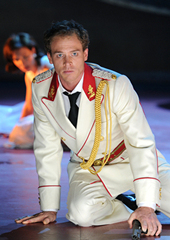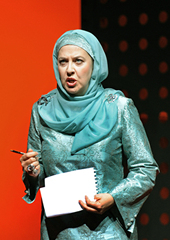Fine voices at the heart of Göttingen's Tamerlano
by Catriona Graham
International Händel-Festspiele Göttingen
May 2010
 Sometimes,
a performer dominates the stage irrespective of the importance of the
character. It has nothing to do with scene-stealing; it just is, and
Franziska Gottwald as Irene in the International Händel-Festspiele Göttingen's
production of Tamerlano just is.
Sometimes,
a performer dominates the stage irrespective of the importance of the
character. It has nothing to do with scene-stealing; it just is, and
Franziska Gottwald as Irene in the International Händel-Festspiele Göttingen's
production of Tamerlano just is.
The lady has style, thanks to Erika Landertinger's costumes, and a wonderfully liquid alto voice which is all her own. From her arrival with her wheelie cabin bag - later revealed to contain her wedding clothes - she draws the eyes and ears, albeit not those of her intended, Tamerlano, as she prowls the stage with feline grace.
That is not to decry the others. Christopher Ainslie's light alto is capable of considerable menace as Tamerlano. Rarely has the word 'Amigo' been sung with such a chill, and his trills and runs ooze threats. His slender body belies the character's strength, illustrated not least by arm-wrestling his ally Andronico, the stockier-built Clint van der Linde.
This modern-dress production is about power and powerlessness. Tamerlano has defeated and captured Bajazet, the Ottoman Sultan, and now wants his daughter, Asteria, whose love of the Greek prince Andronico is reciprocated. As a reward for his support, Tamerlano offers him Irene, Byzantine princess of Trabizond, which would unite the two Greek kingdoms.
We first see Bajazet sitting cross-legged in prison. Tamerlano seeks to humiliate his defeated enemy, by taking his daughter, by shaving his beard. He plots his vengeance in response to Asteria's murder attempts, but is defeated by Bajazet's own suicide. The nobility of the conquered sultan in dying as in life so affects Tamerlano that he accepts Irene, and gives Asteria back to Andronico.
Thomas Cooley plays Bajazet with dignity and grace. He has failed to protect his people from the conquering Tartars, now he cannot protect his daughter from Tamerlano. The anguish is patent, but there is no self-pity. His on-stage suicide is restrained and effective, and his relationship with his daughter is affectionate and unforced.
 The
opera is almost more about Andronico, given the number of anguished arias
through which he works his love for Asteria and concerns about Tamerlano,
to which van der Linde's controlled ritenutos add conviction.
The
opera is almost more about Andronico, given the number of anguished arias
through which he works his love for Asteria and concerns about Tamerlano,
to which van der Linde's controlled ritenutos add conviction.
Kristina Hansson gives Asteria a determination - as well as a flirtatious sweetness in her duet with Andronico in which they declare their love through passing each other notes. In her ornate wedding dress, pacing out patterns on the stage with tiny, rapid steps, she conveys her distress at impending marriage to Tamerlano and the opportunity to kill him.
Lars Arvidson plays Leone, sidekick variously to Andronico and Tamerlano, as slightly detached from the action - trying to get away from yet another aria in which Andronico sings of his despair, his love for Asteria, his despair; reluctance to carry out orders, yet forced to polish Tamerlano's boots with the shirt ripped from his back. His steady bass provides a solid bottom to the ensemble.
Martin Kukulies' set is stark - red-lit except for one scene with a light blue-lit backdrop - with only a coffin-like black chest and two tall, square, perforated towers which glide (at times disconcertingly Dalek-like) to form walls, doors and prisons. Johanna Garpe directs it with a lot of movement, at times rather busy - particularly a rather balletic symbolic group sex during one of Andronico's arias.
Nicholas McGegan and the Festspiel Orchester Göttingen do full justice to Handel's score and provide a well-balanced accompaniment to the singers on stage. In the final quartet, acknowledging the end of a long day and anticipating a better tomorrow, the voices weave together movingly in a fitting completion.
Photos © Theodoro da Silva